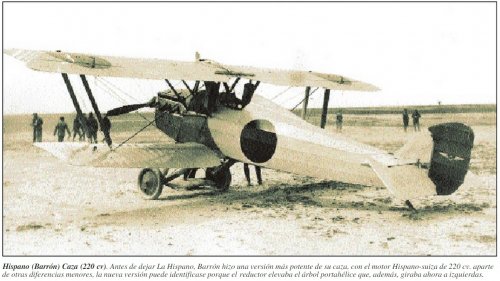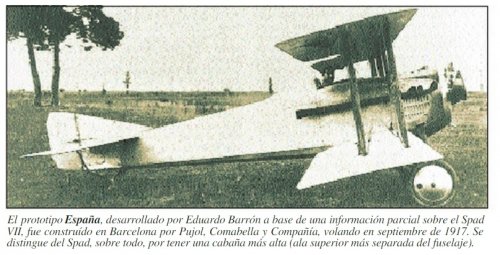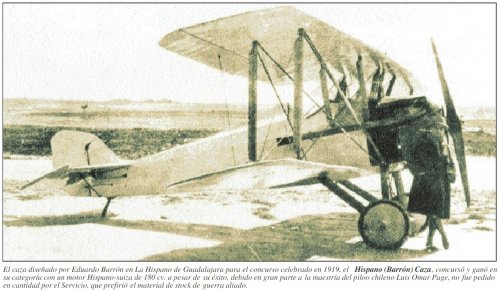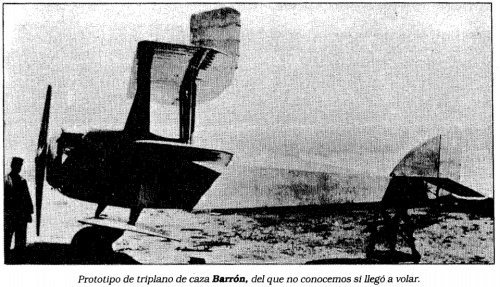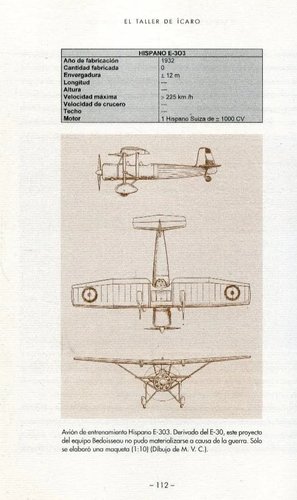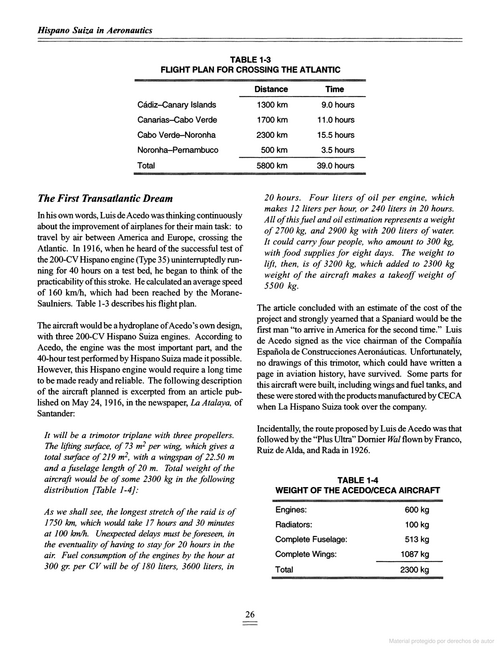Here is a topic for the aircraft made in Spain by the companies related to Hispano.
Aircraft built by CECA (Compañía Española de Construcciones Aeronáuticas) in Santander, closely related to La Hispano Suiza:
- CECA-MS or CECA-Saulnier, Morane-Saulnier BB made under license with Hispano V-8 engine, 12 built, 1916
- (Trimotor Acedo), no-name three-engine flying boat for transatlantic flight, some parts made but aircraft never completed, 1916
Aircraft designed by Barrón for La Hispano in Guadalajara:
- Hispano-Barrón no-name observation biplane, prototype, 1919
- Hispano-Barrón no-name fighter biplane, prototype, 1919
Aircraft built under license by La Hispano Aircraft, later La Hispano, in Guadalajara:
- Airco DH.6 or E-180 (Entrenamiento or Escuela, 180cv), 45 built with Hispano 180hp engine, 1921
- Airco DH.9, 200 built with Hispano 300hp engine, 1922-28
- Hispano-Albatros, Hispano 300hp engine, one prototype, perhaps an old Albatros aircraft refurbished, 1923
- Potez 25, license production was planned but abandoned, 1925
- Nieuport 52, Hispano 12 Hb 500hp, 100 built, 1928
- Hawker Spanish Fury, Hispano 12 Xbrs, license production of 50 was planned but cancelled in 1936
Aircraft designed by La Hispano in Guadalajara:
- AET-Roa, sesquiplane designed by Vicente Roa, Hispano 300hp engine, prototype started but not completed, 1926
- E-30 (Entrenamiento or Escuela, 1930), two-seat parasol-wing monoplane trainer, designed by André Bédoiseau:
-- first prototype called E-30 H, with Hispano 8 Ab
-- second prototype with Hispano 9 Qa
-- third prototype, STOL version with Handley-Page slats and flaps
-- 28 series production aircraft with Hispano 9 Qd
- E-303 (or E-303 H or HS-303), larger armed version with Hispano 14 AA, not built
- HS-34 (or E-34, for Entrenamiento or Escuela, 1934), two-seat biplane trainer, designed by Vicente Roa, 2 prototypes built, 25 series aircraft started, of which only one was completed in Guadalajara, 4 were completed by SAF-5 in Alicante, and another was assembled from spare parts by La Hispano Suiza in Sevilla after the Civil War
- C-36 (Caza, 1936), monoplane fighter with Hispano 14 HA, designed by Enrique Corbella, some parts built by SAF-5 in Alicante
- RBL-36 (Reconocimiento y Bombardeo Ligero, 1936), monoplane observation and light bomber with Hispano 14 HA, designed by Enrique Corbella, not built
Aircraft built under license or modified by SAF-5, later SAF-15, in Alicante (ex-La Hispano):
- Fokker C.X, one prototype built with Russian M-100 engine, 25 series aircraft started but not completed
- Fokker D.XXI, one prototype built with Russian M-25 engine, 50 series aircraft started but not completed
- Polikarpov I-16, 50 built, some of which were completed after the Civil War
- Focke-Wulf Fw.56 Stösser, one aircraft modified with Hispano 9 Qa, four others planned
- Dewoitine D.510, two aircraft modified with Russian M-100 engine
- Vultee V-1A, six aircraft militarized with machine guns and bombs
Aircraft of foreign design built by La Hispano Suiza in Sevilla:
- HS-132 L, license production verions of the Fiat CR.32, 100 built
- Fiat G.50, license production planned but cancelled
- Fiat CR.32 doble mando, two-seat trainer version, 31 aircraft modified, of which 29 were Italian-built and 2 were HS-132 L
- project to modify the CR.32 with different engines: Hispano 12 Xbrs, 14 AA or 14 AB
Derivatives of the Bf 109, designed and built by La Hispano Suiza or La Hispano Aviación in Sevilla :
- Messerschmitt Bf 109 E-1 (sometimes wrongly reported as Bf 109 F), one German aircraft transformed in Barcelona with Hispano 12 Z
- HA-1109 J.1L or JL (first called Bf 109 J or Me 109 J), with Hispano 12 Z
- HA-1109 K.1L, with Hispano 12 Z-17 or 12 Z-M, unarmed
- HA-1109 K.2L, K.3L and K.4L (unconfirmed), prototype armed variants of the HA-1109 K.1L
- HA-1109 M.1L, same as HA-1109 K.1L with RR Merlin
- HA-1109 M.2L and M.3L, studies for armed variants of the HA-1109 M.1L
- HA-1110 K.1L, two prototype two-seat aircraft with 12 Z-M
- HA-1110 M.1L or HA-1112 M.4L (depending on the source), the two HA-1110 K.1L modified with RR Merlin
- HA-1111 K.1L, study for a single-seat version with 12 Z-17 or 12 Z-M and wing tip tanks
- HA-1112 K.1L, single-seat version with 12 Z-17 or 12 Z-M, wing cannons, rockets and wing fences
For those aircraft, the main number (1109, 1110, 1111, 1112) seems to correspond to the airframe variant :
- 1109 = unmodified airframe
- 1110 = two-seater
- 1111 = wings modified for wing tip tanks
- 1112 = wings further reinforced for wing armament, and addition of wing fences
The first letter (J, K, L) corresponds to the engine :
- J = Hispano 12 Z (type 89)
- K = Hispano 12 Z-17 or 12 Z-M
- M = RR Merlin
The only designation which does not fit this scheme is HA-1112 M.4L. It is not used by Lage, who gives HA-1110 M.1L instead.
Military designation was C.4-J with Hispano engine and C.4-K with Merlin (single-seat and two-seat versions alike).
Aircraft designed by La Hispano Suiza in Sevilla:
- HS-40, evolution of the pre-war E-303, not built, c.1940, no data
- HS-41, perhaps a new name for the modified HS-34 assembled from spare parts in 1941
- HS-42, two-seat monoplane trainer, 1942:
-- originally planned with HS-93 engine (itself not built), also planned with Argus As-410
-- two prototypes with Piaggio P-VII
-- HS-42 A, first series with Piaggio P-VII, 15 built
-- HS-42 B, with Armstrong Siddeley Cheetah XXV and sliding canopy, 48 built, one of which was completed as HS-43 B / HA-43 B
-- HS-42 C, planned with Elizalde Sirio, not built
-- HS-42 D.1, similar to the HS-42 B with Armstrong Siddeley Cheetah XXVII, 10 built
-- HS-42 D.2, similar, 27 built
-- HS-42 D.3, 12 ex-HS-42 A refurbished with Cheetah XXVII
-- HS-42 D.4, 13 built, with Cheetah XXVII, ordered as HA-43 D but completed with fixed landing gear
- HS-43 or HA-43, evolution of the HS-42 with retractable landing gear:
-- HS-43 B or HA-43 B, first prototype taken from the HS-42 B production, first flight in 1948
-- HA-43 C, series version planned with Elizalde Sirio, not built
-- HA-43 B.1, later HA-43 D, with Cheetah XXVII, modified HA-43 B prototype and 2 additional built, remaining aircraft completed as HS-42 D.4
- HS-50, single-seat fighter designed by Émile Dewoitine as D.600, with HS-89 12-Z engine, c.1941-43, not built but for a full scale mock-up and the landing gear assembly
- HS-60, two-engine trainer and light bomber, with HS-93 engines, c.1942, not built
The aircraft branch became La Hispano Aviación in 1943, and the prefix was switched from HS to HA, from the HA-43 onwards.
Aircraft designed by La Hispano Aviación in Sevilla:
- HA-100 Triana, two-seat armed trainer, military designation XE-12, serial production cancelled :
-- HA-100 E-1 Triana, with ENMASA Beta engine, studied from 1952, two prototypes built, first flew in 1953
-- HA-100 F-1 Triana, same with Wright Cyclone, two prototypes built, first flew in 1955
- HA-110 C-1, same but unarmed, with ENMASA Sirio, studied from 1952, two unfinished prototypes, military designation XE-13
- HA-120 R-1, jet derivative of the HA-100, with Turbomeca Marboré II, studied from 1952
- HA-200 Saeta, jet trainer:
-- HA-200 R-1, evolved from the HA-120, two prototypes, military designation XE-14, first flight in 1955, and 10 preseries aircraft
-- HA-200 A, series production version for Spain, 30 built, military designation E-14 A, first delivered in 1962
-- HA-200 B Al Kahira, armed version for Egypt, 5 built in Spain from 1959 (some say that they were ex-preseries HA-200 R-1), others assembled or built in Egypt (at least 46, some say 90)
-- HA-200 C, planned single-seat variant, c.1957
-- HA-200 D, second series production version for Spain, 55 built, military designation E-14 B, first delivered in 1965
-- HA-200 E, evolution of the HA-200 D incorporating features from the HA-210 such as the Marboré VI and the new air intake, with underwing armament and other minor changes, one prototype built, first flight in 1965 ; the HA-200 D were later upgraded with military designation C-10 B, incorporating some modifications of the HA-200 E
-- HA-200 F, planned single-seat variant of the HA-200 for light attack, c.1966
-- HA-200 G, perhaps the first name of the HA-220, c.1968
- HA-210, planned evolution of the HA-200 with Marboré VI, ejection seats, new canopy, new air intake and other modifications, c.1963
- HA-220 Super Saeta, single-seat light attack evolution of the HA-200 E, with the Marboré VI and new air intake, first flight in 1970, 25 built, military designation C-10 C
- HA-230 R-1, four-seat liaison aircraft project, based of the HA-200, military designation XL-11, date unclear, between 1956 and 1959
- HA-231 R-1, six-seat project, evolved from the HA-230, same military designation XL-11, date unclear, between 1956 and 1960
- HA-300, supersonic fighter, studied from 1953, program cancelled and sold to Egypt in 1959, three prototypes completed in Helwan, with first flight in 1964, fourth prototype unfinished, program terminated in 1969
- HA-300 P or P-300, other names for the HA-23 P glider
- HA-310, two-engine variant of the HA-300, project only, c.1957
- HA-400, cargo aircraft project with four RR Dart-7 turbomotors, c.1958
- HA-500 Alacrán, light attack and CO-IN twin jet project, with short take-off, 1967-69, proposed concurrently with the Messerschmitt Me-400 designed in Germany, of quite similar characteristics
- HA-23 P, glider aircraft, flying mock-up for the HA-300, one prototype, flown in 1959
- HA-23, internal name for the HA-300 :
-- HA-23 I, the first unarmed prototype
-- HA-23 II, planned second prototype, with armament
- HA-25, two-seat jet trainer project, 1971, became the CASA C-101 Aviojet after merge with CASA
- HA-56, six-seat business jet project, developed after the HA-231, with new fuselage and two turbofans, two engine configurations were successively contemplated, 1960-61
- HA-57, single-seat light attack variant of the HA-200 with Marboré VI, c.1960, one fuselage built
- HA-60 Super Saeta, all new design for single-seat light attack aircraft, at least three configurations were contemplated, c.1961
Aircraft of foreign design built by La Hispano Aviación in Sevilla:
- SIAT-223 Flamingo, first Spanish-built aircraft flew in 1972, 50 built in total after merge with CASA
- Bölkow Bo-209 Monsun, licence production planned but cancelled
The company was finally merged into CASA in 1972.
Main sources:
- Hispano-Suiza 1904-1972 – Hombres, empresas, motores y aviones by Manuel Lage, LID, 2003, ISBN 8488717296, or its English version Hispano Suiza in Aeronautics: Men, Companies, Engines and Aircraft, SAE International, 2003, ISBN 0768009979
- "El cuarteto De Havilland: Rolls/Escuela/Hispano/Napier", by José Warleta Carrillo, in Aeroplano no.5, 1987
- "Eduardo Barrón y Ramos de Sotomayor", by José Warleta Carrillo, in Aeroplano no.6, 1989
- Les Messerschmitt espagnols, Avions special issue no.5
Aircraft built by CECA (Compañía Española de Construcciones Aeronáuticas) in Santander, closely related to La Hispano Suiza:
- CECA-MS or CECA-Saulnier, Morane-Saulnier BB made under license with Hispano V-8 engine, 12 built, 1916
- (Trimotor Acedo), no-name three-engine flying boat for transatlantic flight, some parts made but aircraft never completed, 1916
Aircraft designed by Barrón for La Hispano in Guadalajara:
- Hispano-Barrón no-name observation biplane, prototype, 1919
- Hispano-Barrón no-name fighter biplane, prototype, 1919
Aircraft built under license by La Hispano Aircraft, later La Hispano, in Guadalajara:
- Airco DH.6 or E-180 (Entrenamiento or Escuela, 180cv), 45 built with Hispano 180hp engine, 1921
- Airco DH.9, 200 built with Hispano 300hp engine, 1922-28
- Hispano-Albatros, Hispano 300hp engine, one prototype, perhaps an old Albatros aircraft refurbished, 1923
- Potez 25, license production was planned but abandoned, 1925
- Nieuport 52, Hispano 12 Hb 500hp, 100 built, 1928
- Hawker Spanish Fury, Hispano 12 Xbrs, license production of 50 was planned but cancelled in 1936
Aircraft designed by La Hispano in Guadalajara:
- AET-Roa, sesquiplane designed by Vicente Roa, Hispano 300hp engine, prototype started but not completed, 1926
- E-30 (Entrenamiento or Escuela, 1930), two-seat parasol-wing monoplane trainer, designed by André Bédoiseau:
-- first prototype called E-30 H, with Hispano 8 Ab
-- second prototype with Hispano 9 Qa
-- third prototype, STOL version with Handley-Page slats and flaps
-- 28 series production aircraft with Hispano 9 Qd
- E-303 (or E-303 H or HS-303), larger armed version with Hispano 14 AA, not built
- HS-34 (or E-34, for Entrenamiento or Escuela, 1934), two-seat biplane trainer, designed by Vicente Roa, 2 prototypes built, 25 series aircraft started, of which only one was completed in Guadalajara, 4 were completed by SAF-5 in Alicante, and another was assembled from spare parts by La Hispano Suiza in Sevilla after the Civil War
- C-36 (Caza, 1936), monoplane fighter with Hispano 14 HA, designed by Enrique Corbella, some parts built by SAF-5 in Alicante
- RBL-36 (Reconocimiento y Bombardeo Ligero, 1936), monoplane observation and light bomber with Hispano 14 HA, designed by Enrique Corbella, not built
Aircraft built under license or modified by SAF-5, later SAF-15, in Alicante (ex-La Hispano):
- Fokker C.X, one prototype built with Russian M-100 engine, 25 series aircraft started but not completed
- Fokker D.XXI, one prototype built with Russian M-25 engine, 50 series aircraft started but not completed
- Polikarpov I-16, 50 built, some of which were completed after the Civil War
- Focke-Wulf Fw.56 Stösser, one aircraft modified with Hispano 9 Qa, four others planned
- Dewoitine D.510, two aircraft modified with Russian M-100 engine
- Vultee V-1A, six aircraft militarized with machine guns and bombs
Aircraft of foreign design built by La Hispano Suiza in Sevilla:
- HS-132 L, license production verions of the Fiat CR.32, 100 built
- Fiat G.50, license production planned but cancelled
- Fiat CR.32 doble mando, two-seat trainer version, 31 aircraft modified, of which 29 were Italian-built and 2 were HS-132 L
- project to modify the CR.32 with different engines: Hispano 12 Xbrs, 14 AA or 14 AB
Derivatives of the Bf 109, designed and built by La Hispano Suiza or La Hispano Aviación in Sevilla :
- Messerschmitt Bf 109 E-1 (sometimes wrongly reported as Bf 109 F), one German aircraft transformed in Barcelona with Hispano 12 Z
- HA-1109 J.1L or JL (first called Bf 109 J or Me 109 J), with Hispano 12 Z
- HA-1109 K.1L, with Hispano 12 Z-17 or 12 Z-M, unarmed
- HA-1109 K.2L, K.3L and K.4L (unconfirmed), prototype armed variants of the HA-1109 K.1L
- HA-1109 M.1L, same as HA-1109 K.1L with RR Merlin
- HA-1109 M.2L and M.3L, studies for armed variants of the HA-1109 M.1L
- HA-1110 K.1L, two prototype two-seat aircraft with 12 Z-M
- HA-1110 M.1L or HA-1112 M.4L (depending on the source), the two HA-1110 K.1L modified with RR Merlin
- HA-1111 K.1L, study for a single-seat version with 12 Z-17 or 12 Z-M and wing tip tanks
- HA-1112 K.1L, single-seat version with 12 Z-17 or 12 Z-M, wing cannons, rockets and wing fences
For those aircraft, the main number (1109, 1110, 1111, 1112) seems to correspond to the airframe variant :
- 1109 = unmodified airframe
- 1110 = two-seater
- 1111 = wings modified for wing tip tanks
- 1112 = wings further reinforced for wing armament, and addition of wing fences
The first letter (J, K, L) corresponds to the engine :
- J = Hispano 12 Z (type 89)
- K = Hispano 12 Z-17 or 12 Z-M
- M = RR Merlin
The only designation which does not fit this scheme is HA-1112 M.4L. It is not used by Lage, who gives HA-1110 M.1L instead.
Military designation was C.4-J with Hispano engine and C.4-K with Merlin (single-seat and two-seat versions alike).
Aircraft designed by La Hispano Suiza in Sevilla:
- HS-40, evolution of the pre-war E-303, not built, c.1940, no data
- HS-41, perhaps a new name for the modified HS-34 assembled from spare parts in 1941
- HS-42, two-seat monoplane trainer, 1942:
-- originally planned with HS-93 engine (itself not built), also planned with Argus As-410
-- two prototypes with Piaggio P-VII
-- HS-42 A, first series with Piaggio P-VII, 15 built
-- HS-42 B, with Armstrong Siddeley Cheetah XXV and sliding canopy, 48 built, one of which was completed as HS-43 B / HA-43 B
-- HS-42 C, planned with Elizalde Sirio, not built
-- HS-42 D.1, similar to the HS-42 B with Armstrong Siddeley Cheetah XXVII, 10 built
-- HS-42 D.2, similar, 27 built
-- HS-42 D.3, 12 ex-HS-42 A refurbished with Cheetah XXVII
-- HS-42 D.4, 13 built, with Cheetah XXVII, ordered as HA-43 D but completed with fixed landing gear
- HS-43 or HA-43, evolution of the HS-42 with retractable landing gear:
-- HS-43 B or HA-43 B, first prototype taken from the HS-42 B production, first flight in 1948
-- HA-43 C, series version planned with Elizalde Sirio, not built
-- HA-43 B.1, later HA-43 D, with Cheetah XXVII, modified HA-43 B prototype and 2 additional built, remaining aircraft completed as HS-42 D.4
- HS-50, single-seat fighter designed by Émile Dewoitine as D.600, with HS-89 12-Z engine, c.1941-43, not built but for a full scale mock-up and the landing gear assembly
- HS-60, two-engine trainer and light bomber, with HS-93 engines, c.1942, not built
The aircraft branch became La Hispano Aviación in 1943, and the prefix was switched from HS to HA, from the HA-43 onwards.
Aircraft designed by La Hispano Aviación in Sevilla:
- HA-100 Triana, two-seat armed trainer, military designation XE-12, serial production cancelled :
-- HA-100 E-1 Triana, with ENMASA Beta engine, studied from 1952, two prototypes built, first flew in 1953
-- HA-100 F-1 Triana, same with Wright Cyclone, two prototypes built, first flew in 1955
- HA-110 C-1, same but unarmed, with ENMASA Sirio, studied from 1952, two unfinished prototypes, military designation XE-13
- HA-120 R-1, jet derivative of the HA-100, with Turbomeca Marboré II, studied from 1952
- HA-200 Saeta, jet trainer:
-- HA-200 R-1, evolved from the HA-120, two prototypes, military designation XE-14, first flight in 1955, and 10 preseries aircraft
-- HA-200 A, series production version for Spain, 30 built, military designation E-14 A, first delivered in 1962
-- HA-200 B Al Kahira, armed version for Egypt, 5 built in Spain from 1959 (some say that they were ex-preseries HA-200 R-1), others assembled or built in Egypt (at least 46, some say 90)
-- HA-200 C, planned single-seat variant, c.1957
-- HA-200 D, second series production version for Spain, 55 built, military designation E-14 B, first delivered in 1965
-- HA-200 E, evolution of the HA-200 D incorporating features from the HA-210 such as the Marboré VI and the new air intake, with underwing armament and other minor changes, one prototype built, first flight in 1965 ; the HA-200 D were later upgraded with military designation C-10 B, incorporating some modifications of the HA-200 E
-- HA-200 F, planned single-seat variant of the HA-200 for light attack, c.1966
-- HA-200 G, perhaps the first name of the HA-220, c.1968
- HA-210, planned evolution of the HA-200 with Marboré VI, ejection seats, new canopy, new air intake and other modifications, c.1963
- HA-220 Super Saeta, single-seat light attack evolution of the HA-200 E, with the Marboré VI and new air intake, first flight in 1970, 25 built, military designation C-10 C
- HA-230 R-1, four-seat liaison aircraft project, based of the HA-200, military designation XL-11, date unclear, between 1956 and 1959
- HA-231 R-1, six-seat project, evolved from the HA-230, same military designation XL-11, date unclear, between 1956 and 1960
- HA-300, supersonic fighter, studied from 1953, program cancelled and sold to Egypt in 1959, three prototypes completed in Helwan, with first flight in 1964, fourth prototype unfinished, program terminated in 1969
- HA-300 P or P-300, other names for the HA-23 P glider
- HA-310, two-engine variant of the HA-300, project only, c.1957
- HA-400, cargo aircraft project with four RR Dart-7 turbomotors, c.1958
- HA-500 Alacrán, light attack and CO-IN twin jet project, with short take-off, 1967-69, proposed concurrently with the Messerschmitt Me-400 designed in Germany, of quite similar characteristics
- HA-23 P, glider aircraft, flying mock-up for the HA-300, one prototype, flown in 1959
- HA-23, internal name for the HA-300 :
-- HA-23 I, the first unarmed prototype
-- HA-23 II, planned second prototype, with armament
- HA-25, two-seat jet trainer project, 1971, became the CASA C-101 Aviojet after merge with CASA
- HA-56, six-seat business jet project, developed after the HA-231, with new fuselage and two turbofans, two engine configurations were successively contemplated, 1960-61
- HA-57, single-seat light attack variant of the HA-200 with Marboré VI, c.1960, one fuselage built
- HA-60 Super Saeta, all new design for single-seat light attack aircraft, at least three configurations were contemplated, c.1961
Aircraft of foreign design built by La Hispano Aviación in Sevilla:
- SIAT-223 Flamingo, first Spanish-built aircraft flew in 1972, 50 built in total after merge with CASA
- Bölkow Bo-209 Monsun, licence production planned but cancelled
The company was finally merged into CASA in 1972.
Main sources:
- Hispano-Suiza 1904-1972 – Hombres, empresas, motores y aviones by Manuel Lage, LID, 2003, ISBN 8488717296, or its English version Hispano Suiza in Aeronautics: Men, Companies, Engines and Aircraft, SAE International, 2003, ISBN 0768009979
- "El cuarteto De Havilland: Rolls/Escuela/Hispano/Napier", by José Warleta Carrillo, in Aeroplano no.5, 1987
- "Eduardo Barrón y Ramos de Sotomayor", by José Warleta Carrillo, in Aeroplano no.6, 1989
- Les Messerschmitt espagnols, Avions special issue no.5

